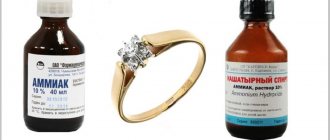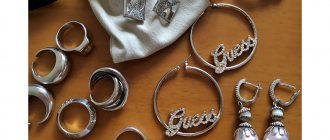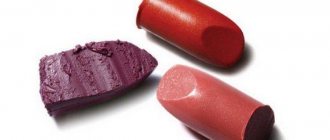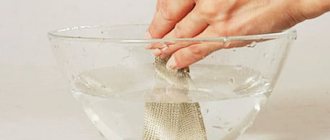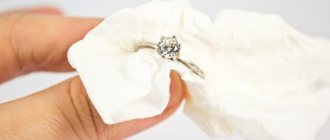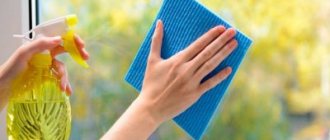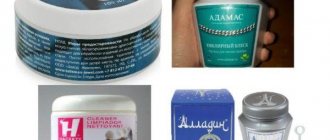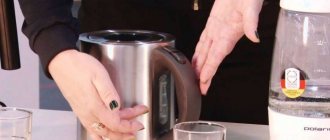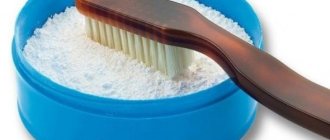Home page » Home and comfort » Caring for jewelry
Author of the article
Svetlana Pavlikhina
Reading time: 7 minutes
AA
It often happens that your favorite silver jewelry begins to darken. Why does blackness appear on metal? How to remove dark plaque? Many people have these questions.
Cleaning silver using ammonia is a popular and effective way to return your jewelry to its original appearance. For this, other components that do not negatively affect this metal can be used.
Why does silver darken?
Silver items often tarnish. This can happen several years after purchasing the jewelry or as early as the next week after wearing a ring or chain.
Silver oxidizes when sweat comes into contact with it. It contains amino acids and salts, as well as sulfur, under the influence of which jewelry begins to turn black.
Reasons why silver darkens:
- excessive human sweating;
- hormonal changes;
- admixture of other components in silver, in particular copper;
- use of cosmetics;
- use of certain medications;
- settling of dirt and dust on silver;
- metal quality.
The following factors also affect the rate of blackening of the product:
- humidity and air composition;
- frequent contact with dirty water;
- product surface shape;
- some household chemicals;
- contact with products such as egg yolk, salt, onion;
- friction against clothing made of synthetic material;
- silver sample.
Jewelry made from this metal can be cleaned from blackness.
Causes of plaque on silver
It was once believed that silver darkens if its owner is damaged, but then the reasons for the appearance of the plaque were explained from a scientific point of view:
- The quality of the metal is indicated by the sample number, and the higher it is, the better the silver. For silver products this is 925 standard. The higher sample number 999 is used mainly for spraying due to the fragility of the structure. A low sample indicates that copper has been added to the alloy, and it easily oxidizes and quickly darkens.
- Various salts and substances in sweat secretions cause oxidative processes in silver, so the surface of jewelry darkens from constant wear. This is especially noticeable if there are problems with the gastrointestinal tract, for example, gastritis with high acidity - the composition of sweat changes, which affects the condition of the metal.
- Cosmetics contain sulfur, which interacts with silver molecules, and chains and rings should be removed when applying cosmetics.
- Keeping silver in a humid or high sulfur environment will also cause tarnish.
Precautionary measures
It must be remembered that when cleaning jewelry with ammonia, precautions should be taken. This substance is a powerful solvent and has a strong odor, so it can be harmful to health .
When working with ammonia, you must adhere to the following rules:
- Do not allow skin contact with the solution. It is advisable to work with the substance wearing rubber gloves.
- It is not allowed to breathe ammonia vapors, so cleaning must be done with a respirator or a face covering.
- If the solution accidentally gets on the mucous membranes, you should rinse them with water. If necessary, you should seek medical help.
It is best to use tweezers to remove silver from solution.- After cleaning, the product should be rinsed thoroughly to avoid causing skin burns or poisoning.
- After processing silver, it is necessary to ventilate the room.
If the product is made of gold-plated silver, then it is not recommended to use ammonia solution. For jewelry with stones, the dose of ammonia should be reduced.
Ammonia and silver
Ammonia effectively removes blackness from silver and gold due to its ability to react with any chemical oxidizing agent, converting it into ammonium salts, which allows it to be a very good solvent. At the same time, its peculiarity is that ammonia does not affect gold and silver when removing plaque, which allows it to be used without the risk of damaging the precious metal.
The only point that needs to be taken into account when cleaning is that you cannot soak silver and gold in the same solution, as they will react, resulting in yellow silver and white gold. It is not recommended to use ammonia to clean gold-plated silver, as well as items with pearls. For products that contain other precious stones, when preparing the solution, you need to reduce the amount of ammonia.
Effective cleaning methods
At home, you can clean silver with ammonia using the following components:
- water;
- dentifrice;
- hydrogen peroxide.
They are the most effective for cleaning silver jewelry from tarnish.
Ammonia and water
To prepare the product, take ammonia and clean water in a ratio of 1:10. The solution is mixed well.
Cleaning algorithm:
Place the products in a container with the solution and leave for 30 minutes. If the silver is very black, you can soak it for an hour, but no more.- Remove the jewelry using tweezers and wipe with a dry cloth.
- Silver should be rinsed well under running water and cleaned until shiny.
In case of a small dark deposit, you can soak a piece of flannel or woolen cloth in the solution and wipe the decoration.
In case of strong blackness, it is recommended to use ammonia diluted in water in a ratio of 1:4.
With tooth powder or paste
You can quickly remove dirt with powder. However, if there are stones on the product, then this method is undesirable.
To do this, take the following ingredients:
- ammonia - 1 tbsp;
- warm water – 2 tablespoons;
- tooth powder - half a tablespoon.
You can use paste. The components are mixed and proceed to cleaning:
- Soak a sponge in the mixture and thoroughly wipe the decoration.
- After removing contamination, rinse the product under running warm water.
- Wipe with a soft cloth.
Strong blackness can be removed as follows: apply the product to the brush and thoroughly clean the surface of the jewelry.
Recipe with hydrogen peroxide
Cleaning procedure:
- 1 tbsp. Dilute peroxide and ammonia in 0.5 liters of warm water.
- Immerse the decoration in the solution for 20 minutes.
- Wash the product well with water.
- Polish with a clean and dry cloth.
It is also recommended to add a little liquid baby soap to this mixture. It can also be replaced with detergent.
Preparing the product for cleaning
To clean silver or gold with ammonia, you may need:
- Toothbrush;
- sponge, wool or flannel fabric (under no circumstances should you use abrasive substances or hard brushes to clean silver: they can scratch it and ruin the appearance of the product);
- a container for the solution (it should be borne in mind that it cannot subsequently be used for cooking);
- paper napkins;
- rubber gloves and tweezers.
The cleaning method largely depends on the product: if you need to clean, for example, a chain, you should take into account that it consists of many links, which are not easy to get to from all sides, so the best option would be to soak the product. Before you start cleaning the product with ammonia, it is advisable to soak it in a soap solution for a while: most of the blackness will come off and it will be easier to clean the precious metal.
How to restore shine after cleaning
The metal may be cleared of dark deposits, but lose its shine. In this case, the following will help:
- lemon juice;
- baking soda;
- powdered milk.
You can also add shine using foil.
Baking soda
Baking soda can also restore the shine of a dull item. For this:
- Make a thick mixture of water and soda.
- Polish the surface with a toothbrush and product.
- Wash in warm water and dry with a napkin.
The product can be boiled in water with the addition of soda. This should be done for no more than 10 minutes.
In order for the ring to shine perfectly, you should rinse the jewelry very thoroughly after baking soda.
Foil
For this method you will need:
- water – 0.5 l;
- 2 sheets of foil;
- salt – 2 tbsp.
Step-by-step instruction:
Salt is dissolved in water and boiled.- Add foil and stir.
- The decoration is kept in the solution for several minutes.
- The product washes well.
In some sources you can find the same method, only without adding salt.
Lemon juice
If the product has become dull after cleaning, its shine can be restored in the following way:
- Squeeze juice from one lemon.
- Soak a sponge in the liquid.
- Wipe the silver well.
- Wash the jewelry under water.
- Dry with a dry cloth.
If you do this at least once a week, the metal will not darken.
Powdered milk
You can restore the shine and purity of silver using powdered milk. It is diluted with water to the consistency of sour cream, and carefully applied to the product with a toothbrush.
After this procedure, leave the jewelry for a few minutes, then rinse the item in clean water and dry with a paper towel.
You can clean silver with regular milk, only sour milk. To do this, the product is placed in liquid for 2-3 hours.
Rules for using ammonia
Ammonia (ammonia) is a chemical and should be used in accordance with the rules.
What not to do:
- use hard cloths and sponges - the abrasive may scratch the metal surface;
- clean jewelry with pearls - pearls darken from ammonia, losing their quality;
- use a solution with a high concentration of ammonia if the jewelry contains a gemstone (use a weak solution of 250 ml of water and 5 drops of ammonia).
Other cleaning methods
There are many other methods for cleaning silver. These include:
- Egg yolk. Soak a cotton pad in it and rub the product, then let it dry a little and rinse it off.
- Vinegar. Polish the silver with the product for several minutes using a brush or sponge. The vinegar needs to be heated a little first.
- Kefir. Place the decoration in a container with sour milk and leave for 2 hours, then rinse well.
Lemon acid. The product is dissolved in water and simmered in a water bath. They also put a small piece of copper wire and a silver decoration there. Boil for 20 minutes. Wash the silver under running water.- Coca Cola. It is recommended to boil silver in the drink for 10 minutes.
An original way to remove dirt from silver is to clean it with lipstick. Rub the item well with it, then wash it off.
The following methods will also help to give your jewelry a new shine:
- soaking in sour milk;
- rubbing with vinegar;
- polishing with soap mixture;
- soaking in vinegar-soda solution.
After cleaning, you can wash your products not only in plain water; it’s good to add 2 drops of Ferry to it.
What not to clean silver
You should not use detergents and cleaners aimed at dissolving rust and plaque (Domestos, Pemolux and others): acid and alkali can harm silver.
Do not use hard toothbrushes or abrasive sponges. Ammonia should not be used when cleaning blackened metal, since if you are too diligent, the coating may simply come off.
By choosing the wrong method for cleaning silver, it is easy to ruin your jewelry, so you need to approach this process extremely thoughtfully and carefully.
Rules for caring for silver
To prevent silver from darkening, the following rules should be followed:
- Put on jewelry only after the cosmetic oil or cream has been completely absorbed.
- Avoid storing silver in high humidity conditions.
- Remove jewelry when swimming, especially in salt water.
- It is advisable to store the products in a dry place; it is best to wrap them in foil.
- Remove chains and rings before dishwashing or hand washing.
- To prevent silver from oxidizing, it is recommended to place aluminum foil in the box.
- You can put chalk in the storage box to help maintain the shine.
- After removal, it is recommended to wipe the jewelry with a soft, dry cloth.
It is also important to periodically clean silver from plaque.
If you follow these recommendations, you can wear the jewelry longer, because it will turn black less.
Tips for owners of silver products
The surface of silver remains clean longer and you will have to clean it less often if you follow simple recommendations:
- Be sure to wipe the dishes and cutlery dry after washing; paper prevents the appearance of darkening; wrap it in it without tying it with an elastic band;
- when taking a shower, bathing, when visiting a sauna, bathhouse, when doing housework and applying cosmetics, remove jewelry;
- the juice of vegetables and fruits (onions, carrots, beets, red and black currants) oxidizes silver, so it is recommended to remove the rings when cooking;
- regular hair conditioner will prevent oxidation - apply it with a cotton pad or napkin, leave for three minutes, rinse and wipe dry;
- the best place to store silver is a closed box (casket) lined with fabric, a bag, and rarely used items are recommended to be stored wrapped in foil;
- silver coins are stored separately from each other in special albums and boxes;
- Do not use aggressive cleaning agents, hard sponges or brushes.
A silver product will serve you for a long time if you take care of it and follow the operating rules, taking into account the characteristics of the metal.
How do you like the article?
How to clean silver with stones
You can clean silver rings with stones in a jewelry store or at home. You should focus on the density of the stones. Aquamarine, emerald and sapphire can be cleaned with washing powder; laundry soap will help remove grease and dirt from malachite, moonstone, opal and turquoise. Silver earrings with ruby or garnet stones should not be immersed in hot water. It is important to clean jewelry with inserts very carefully and carefully: do not damage the insert itself or loosen the fastenings. Products containing amber, coral or pearls should be washed with lukewarm water and soap. Aggressive cleaning agents can destroy the structure of the stone.
What causes gold to become contaminated?
Why does a once beautiful, shining product become dull and dirty? It's all about the impurities that are used to create jewelry.
Gold in its pure form is a very soft and abrasion-resistant material, the positive property of which is its resistance to corrosion and chemical influences of the environment.
Jewelry made from such material can be damaged simply by squeezing it in your hand. That is why various alloys are added to gold - metals, thanks to which the alloy becomes stronger and slightly changes its color. The ligature transfers some of its properties to the alloy and jewelers have the opportunity to make beautiful, designer, complex jewelry that amazes the eye with an abundance of complex and subtle elements.
The ligature not only gives different shades to gold, but also contributes to its rapid contamination.
Depending on the type of gold, various metals are added. To get yellow gold, just add silver and copper. Manganese, nickel, palladium or platinum makes gold white. The latter is the most expensive version of ligature. Copper gives gold its red color. The higher the copper content in the alloy, the brighter the color. Green gold contains silver or rubidium. Unusual black gold can be made by coating the surface with rhodium or ruthenium, or by oxidizing an alloy of gold, cobalt and chromium.
It is these additives that come into chemical contact with the environment, simultaneously changing the appearance of the jewelry. In addition to the chemical threat of oxidation, there is a threat of contamination of the product. Gold becomes covered with sweat and sebum, gradually losing its original magnificent appearance and shine.
Before you start cleaning, you need to understand that none of the home cleaning methods guarantees a 100% result.
Using a home cleaning method, you need to prepare for unpredictable results. If the product is as expensive as memory, it is better to rely on specialists.
Any cleaning product is designed for alloys, not for stones, so a product that is absolutely harmless to gold can negatively affect precious and semi-precious stones.
Many owners of jewelry do not understand their true composition. White gold can contain both platinum and nickel. Externally, the two alloys are practically indistinguishable for those who do not have professional skills. Platinum is much more resistant than nickel, which can be damaged by aggressive cleaning agents.
It is necessary to carefully clean gold jewelry, taking care not to damage the precious and semi-precious stones.
Any beautiful product has places that are hard to reach for cleaning. Cleaning your home may not completely remove dirt from some parts of the product. If it is fundamentally important to return the jewelry to its original appearance, it is best to contact a professional who can correct all the shortcomings that have appeared over time.
When starting to clean jewelry at home, the owner is fully responsible for the consequences of any recipes read. That is, he takes full responsibility for possible damage to a possibly important and expensive thing.
Any methods that involve scrubbing dirt from a product using a hard brush or powder will inevitably damage the jewelry. The original appearance returns, but not for long. These methods help get rid of the outer layer of dirt and at the same time erase the top layer of alloy from the jewelry, which protects the product from damage and corrosion.
